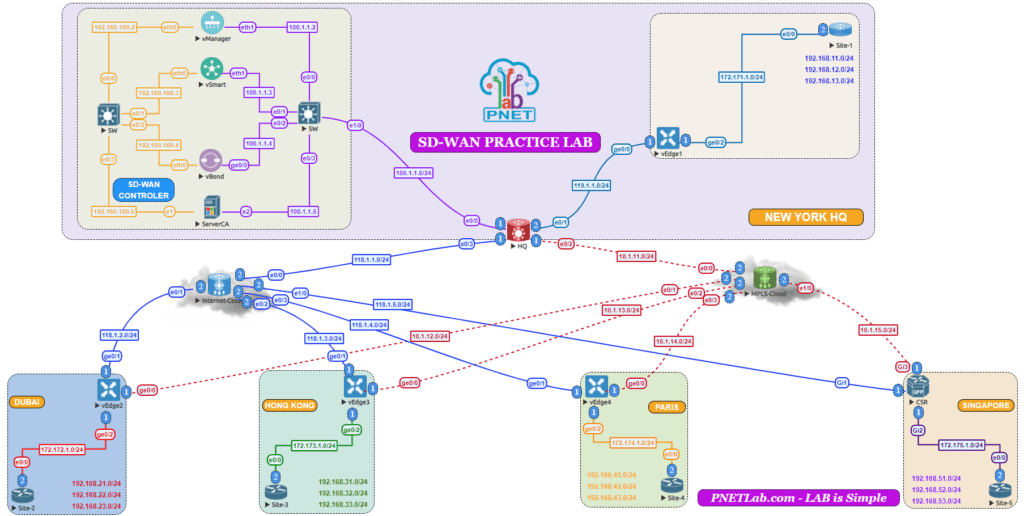SDWAN (Software - Defined Wide Area Network)
Welcome to our Cisco SDWAN course! Cisco SDWAN (Software Defined Wide Area Network) is an advanced networking technology designed to improve the performance, reliability, and security of wide area networks. Our Cisco SDWAN course provides comprehensive training and certification preparation for network engineers who want to learn how to design, deploy, and manage SDWAN infrastructures.
The Cisco SDWAN program covers a wide range of advanced topics, including SDWAN architecture and design, deployment models, configuration, and troubleshooting. Our expert instructors are dedicated to providing you with a comprehensive and hands-on learning experience that will prepare you for success in the real world.
In our Cisco SDWAN course, you will learn how to design, deploy, configure, and troubleshoot SDWAN infrastructures using industry-standard Cisco technologies and tools. You will gain hands-on experience working with the latest SDWAN hardware, software, and automation technologies, as well as mastering advanced routing and switching protocols.
Our Cisco SDWAN course is designed for network engineers who are looking to enhance their skills and take their careers to the next level in the emerging field of software-defined networking. Whether you are a seasoned professional or a recent graduate, our Cisco SDWAN course will provide you with the training and support you need to achieve your career goals.
Thank you for choosing LINT. We look forward to helping you enhance your skills, advance your career, and succeed in the dynamic world of software-defined networking!
1.1 Describe Cisco SD-WAN architecture and components
- 1.1.a Orchestration plane (vBond, NAT)
- 1.1.b Management plane (vManage)
- 1.1.c Control plane (vSmart, OMP)
- 1.1.d Data plane (WAN Edge)
- 1.1.d (i) TLOC
- 1.1.d (ii) IPsec and GRE
- 1.1.d (iii) vRoute
- 1.1.d (iv) BFD
1.2 Describe Cisco SD-WAN Edge platforms and capabilities
1.3 Describe Cisco SD-WAN Cloud OnRamp
- 1.3.a SaaS
- 1.3.b IaaS
- 1.3.c Colocation
2.1 Describe controller cloud deployment
2.2 Describe controller on-premises deployment
- 2.2.a Hosting platform (KVM and Hypervisor)
- 2.2.b Installing controllers
- 2.2.c Scalability and redundancy
2.3 Configure certificates and device lists
2.4 Troubleshoot control plane connectivity between controllers
3.1 Describe WAN Edge deployment
- 3.1.a On-boarding
- 3.1.b Orchestration with zero-touch provisioning and plug-and-play
- 3.1.c Data center and regional hub deployments
3.2 Configure Cisco SD-WAN data plane
- 3.2.a Circuit termination and TLOC-extension
- 3.2.b Dynamic tunnels
- 3.2.c Underlay-overlay connectivity
3.3 Configure OMP
3.4 Configure TLOCs
3.5 Configure CLI and vManage feature configuration templates
- 3.5.a VRRP
- 3.5.b OSPF
- 3.5.c BGP
- 3.5.d EIGRP
3.6 Describe multicast support in Cisco SD-WAN
4.1 Configure control policies
4.2 Configure data policies
4.3 Configure end-to-end segmentation
- 4.3.a VPN segmentation
- 4.3.b Topologies
4.4 Configure Cisco SD-WAN application-aware routing
4.5 Configure direct Internet access
5.1 Configure service insertion
5.2 Describe Cisco SD-WAN security features
- 5.2.a. Application-aware enterprise firewall
- 5.2.b IPS
- 5.2.c URL filtering
- 5.2.d AMP
- 5.2.e SSL and TLS proxy
5.3 Describe Cloud security integration
- 5.3.a. DNS security
- 5.3.b. Secure Internet Gateway (SIG)
5.4 Configure QoS treatment on WAN Edge routers
- 5.4.a Scheduling
- 5.4.b Queuing
- 5.4.c Shaping
- 5.4.d Policing
- 5.4.e Marking
- 5.4.f Per-tunnel and adaptive QoS
6.1 Describe authentication, monitoring, and reporting from vManage
6.2 Configure authentication, monitoring, and reporting
6.3 Describe REST API monitoring
6.4 Describe software image management from vManage

